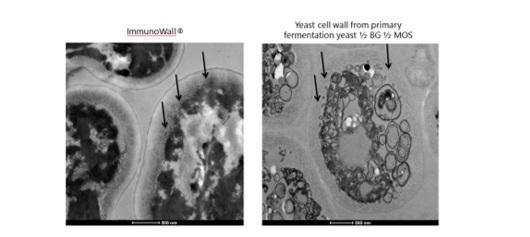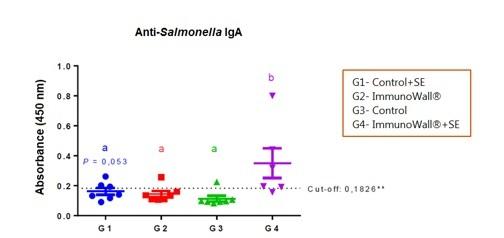ImmunoWall: technology for healthier poultry feed and Salmonella control
Published: June 25, 2019
By: Liliana Longo Borges and Melina Bonato (R&D, ICC Brazil)
The concept of food safety has become increasingly more evident in food production, mainly in relation to the export of products of animal origin, and it is a huge challenge to for the industries to ensure food safety.
The demand for healthier and more natural additives in food has increased in Brazil and the world, resulting in investment in technology and industry adhesion. The technology used in the manufacture of the products is fundamental and integrates techniques for the standardization of production, storage, distribution, and conservation of the nutritional potential of the raw material, which, in addition to improving productivity, enables an increasingly better quality level to be attained. Thus, establishing a link between good quality, nutritional value, and food safety is a task that has demanded a lot of research on the part of industries to ensure public health. Brazil is one the major world producers of meats, exporting to diverse countries, and is also one of the major meat consumers, which show the efficacy of the sanitary standards that act from the field up to the final product.
There is a global concern about the quality of ingredients and additives used in animal feed as a result of the end consumer becoming aware of the relationship between "nutrition and health." Even with increased security and management, Salmonella remains one of the primary causes of food intoxication in the world, and salmonellosis is considered an important public health problem. Therefore, offering safe products, such as Salmonella-free foods, to end consumers is one of the main objectives involving food production technology.
There is a long list of additives that act directly on Salmonella or, indirectly, by modulating the microbiota and immune system response and improving the intestinal integrity of the host. The yeast cell wall (Saccharomyces cerevisiae) is one of the solutions that can help in Salmonella control, by helping to reduce contamination and prevent the problem.
There is a long list of additives that act directly on Salmonella or, indirectly, by modulating the microbiota and immune system response and improving the intestinal integrity of the host. The yeast cell wall (Saccharomyces cerevisiae) is one of the solutions that can help in Salmonella control, by helping to reduce contamination and prevent the problem.
Based on this concept, ImmunoWall® stands out from other products since it is composed of a dense yeast cell wall of Saccharomyces cerevisiae with a high concentration of mannan oligosaccharides (MOS) and β-glucans (BG), resulting in a feed additive with proven results and a great cost/benefit ratio. MOS is known for its ability to agglutinate pathogens. It prevents pathogen colonization in the gut by offering a binding site to harmful bacteria that possess type 1 fimbriae present in the intestinal tract and is excreted together with the faecal material. The β-glucans acts as modulators of the immune response of the animals since they are natural stimulants of the innate immune system. When phagocytic cells are in contact with β-glucans, these cells are stimulated, and cytokines are produced. The production of cytokines triggers a “chain reaction,” inducing a higher immune status in animals, making them better able to resist opportunistic infections.
The yeast culture can be obtained from the ethanol, brewer’s, or baker’s/primary fermentation process. For many years, yeast strains were highlighted as the main important factor in processing. Nowadays, we know that the fermentation environment is more important than the yeast strain and it is the fermentation environment that will indeed provide fundamental differences in the final product’s composition. ImmunoWall® stands out by being produced in a challenging environment during the sugar cane fermentation process to obtain ethanol. The yeast culture passes through numerous fermentation cycles, which makes the yeast cell wall much denser, and results in a higher carbohydrates content and lower fat content, making it less digestible in the intestinal tract.
The process technology of ImmunoWall involves aggressive conditions during ethanol fermentation which leads the yeast to protect itself and, therefore, to strengthen its cell wall. Given that β-glucans are like the yeast cell wall "skeleton", it is important to note the ratio between β-glucans and MOS to measure it effectiveness. The higher the β-glucans concentration, the lower the cell wall degradation in the gastrointestinal tract, and thus, the better its efficiency as "functional fiber". The yeast cell wall has a BG: MOS ratio close to 2: 1, whereas primary yeast cell walls have a 1:1 BG: MOS ratio (Figure 1).

Figure 1. Microscopic structural differences between ImmunoWall and the yeast cell wall from primary fermentation. Light microscopy images performed at the Electron Microscopy Facility, Cellular & Molecular Medicine, University of California San Diego, 2016.
A recent study by Beirão et al. (2018), in which broilers were given ImmunoWall® (0.5 kg/ton) and infected at 2 days of age with Salmonella Enteritidis (SE) (orally at 108 CFU/broiler), showed that ImmunoWall® supplementation resulted in a higher production of anti-Salmonella IgA at 14 days of age. This indicates that the immune system of the broilers given ImmunoWall® had a faster and stronger specific response, thus using less energy and nutrients, since the inflammatory response seemed to be shorter.

Graph 1. Relative IgA quantification in reagent serum against bacterial LPS. The cut-off line is shown. Different letters above each group indicate statistical significance according to an ANOVA test with a Tukey post-test (P<0.05, except when otherwise indicated).
SE can be a problem for broilers that do not yet have a mature immune system since they cannot fully control the infection. For this reason, most of the improved responses found in this study were observed up to day 14. Therefore, β-glucan supplementation can help broilers activate their immune system and have an early and faster innate immune system response, thus reducing/minimizing the damage caused by pathogens and, consequently, performance impairment. This type of response is especially important in animals at early developmental stages, during reproduction, and periods of stress and environmental challenges; β-glucan supplementation thus acts as a prophylactic agent, increasing animals’ resistance, and thus minimizing losses.
In the study published by Hofacre et al. (2017), for the first time in an in vivo experiment, the efficacy of a yeast derived product in reducing the colonization and presence of Salmonella Enteritis (SE) in the ovary and cecum of commercial hens was demonstrated. Table 1 shows that commercial hens contaminated by SE at a high dosage and supplemented with ImmunoWall® (0.5 kg/ton) had a reduction in intestinal and ovarian colonization by SE compared to the control group (at 7 and 14 days after the challenge).
Table 1. Summary of the results of the study by Hofacre et al. (2017) showing the reduction in contamination by Salmonella Enteritidis1 in commercial hens fed ImmunoWall®2

1Infection of chickens at 16 weeks of age by Salmonella Enteritidis (orally, 3.0 x 109 CFU/nalidixic acid-resistant SE chicken). 2ImmunoWall® supplemented from 10 weeks of age at 0.5/ton. 3MPN: most probable number (g of the organ). 4Means followed by different letters on the same line are significantly different to each other according to a Mann-Whitney test (P<0.05).
ImmunoWall®, in addition to being a 100% natural additive, has proven to be a viable solution at low dosages to improve intestinal health and food safety, resulting in an excellent cost/benefit ratio and helping in the reduction of the use of antibiotics.
Beirão, B. C. B. et al.Yeast cell wall immunomodulatory and intestinal integrity effects on broilers challenged with Salmonella Enteritidis. In 2018 PSA Annual Meeting, San Antonio, Texas, USA. Proceedings... 2018.
Hofacre, C. et al. Use of a yeast cell wall product in commercial layer feed to reduce S.E. colonization. in Proceedings of 66th Western Poultry Disease Conference, Sacramento, CA, USA.p. 76-78, 2017.
Ministério da Saúde. [Ministry of Health] Surtos de Doenças Transmitidas por Alimentos no Brasil. [Outbreaks of food transmitted diseases in Brazil]. Available at: http://portalarquivos.saude.gov.br/images/pdf/2016/junho/08/Apresenta----o-Surtos-DTA-2016.pdf
Related topics:
Authors:
ICC
Influencers who recommended :
Talaat Mostafa El-Sheikh, Dr. Ashraf Ali QureshiRecommend
Comment
Share
3 de mayo de 2021
ImmunoWall this is good product, it will be solve many poultry problems
My ask: What about the economical use as a natural additives
Recommend
Reply
Recommend
Reply
Recommend
Reply
Recommend
Reply

Would you like to discuss another topic? Create a new post to engage with experts in the community.










